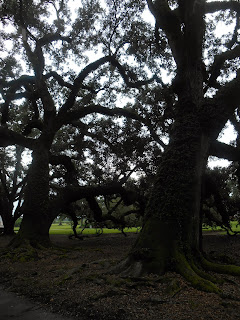The first time I visited Oak Alley plantation in the mid 1990's Slavery was hardly talked about during the tour. All of the slaves were called servants. The local tour guides seem very uncomfortable talking about slavery in the 1990's. Today that has all changed. On my recent visit. Slavery has been incorporated in the tour. On all other sugar plantations in Louisiana, the workforce of enslaved laborers was critical to the success of any plantation and that was no different at Oak Alley.
The slaves were housed in 20 white-washed cypress cabins located in two rows of 10 behind the Big House. Theses cabins have recently been reconstructed as you can see in my photo's. Each slave cabin was a double cabin housing two slave family's built of wood with a central brick fireplace that heated both halves of the cabin. The slaves were thus housed in 40 units. House slaves, referred to as servants, were likely housed in or near the Big House.
Over the years Jacques Télésphore Roman accrued an inventory of 20 house slaves and 93 field slaves, including children. Slavery spanned three decades at Oak Alley and ended in 1865 with the Civil War. A devastated land and the madness of haphazard methods of reconstruction wreaked havoc on former masters and slaves alike, while a whole culture was swept into the uncertainty of a new way of life.
The most noted slave who lived on Oak Alley Plantation was a field slave named Antoine. He was listed as "Antoine, 38, Creole Negro gardener/expert grafter of pecan trees", with a value of $1,000 in the inventory of the estate conducted on J.T. Roman's death in 1848. Antoine was a master of the techniques of grafting and, after trial with several trees, succeeded in the winter of 1846 in producing a variety of pecan that could be cracked with one's bare hands; the shell was so thin it was dubbed the "paper shell" pecan.
It was later named the Centennial Variety when entered in competition at the 1876 Centennial Exposition in Philadelphia, where it won a prize. The trees may be found throughout southern Louisiana, where the pecan was once a considerable cash crop. Although Antoine's original trees were cleared for more sugarcane fields after the Civil War, a commercial grove had been planted at nearby Anita Plantation. Unfortunately, the Anita Crevasse (river break) of 1990 washed away Anita Plantation and all remains of the original Centennial pecans.
The Research and Collections Department at Oak Alley is currently conducting an extensive research effort into these lesser-known plantation residents. How did they live? What did they think of their status as property? Were they families in the modern sense of the word? While we will never know the answers to some of these questions, we are gradually gaining a better understanding of the way slavery functioned socially and economically on this sugar plantation. We have learned that infants were always baptized, there was a strong separation between house and field duties, and the most common punishment was imprisonment. These discoveries, and others, will help illuminate the lives of 158 plus individuals who for many years have been a mystery.




























































Thank you for sharing this. Other than Laura, I've avoided visiting the plantations when in the area for concern about the 'whitewashing' of history with regards to those who lived enslaved there. It's good to know that is changing.
ReplyDeleteHi, I use to work at Laura right after High school. They were one of the first plantations to talk about slavery and then other slowly started to incorporate it into there tour. Thanks for stopping by.
ReplyDelete